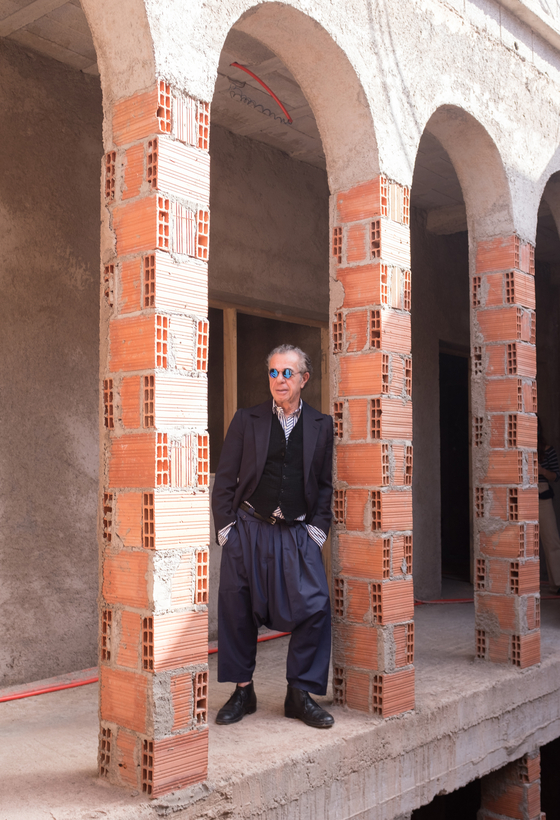The fashion moment. To most people, it’s a largely meaningless, hyperbolic term. But to fashion people (that designation, too, likely rings pretentious/silly to those who don’t self-identify as such) the fashion moment is real, powerful, and even visceral.
It can be a time period—the 90s. It can be a school of fashion—street, grunge, deconstruction. Or a single show—the July couture debut of Balenciaga’s Demna (he formally dropped his surname, Gvasalia, at the end of 2021) and his most recent ready-to-wear collection, shown in Paris last week. Or it can be a designer, the person and the work, over a span of time. Currently, Demna and his output since joining Balenciaga double-qualify.

In the 80s and 90s, Romeo Gigli—the man and his work—was a fashion moment, one that saw the designer thrust into a swirl of breathy excitement and media frenzy that such a designation implies. Now he’s plotting his next act with forays into furniture design and hospitality.
From Milan to Marrakech
Today, Gigli lives far from such industry glare, in Marrakech, where he and his family moved two years ago from Milan. He has loved the city since he first visited as a teenager and found it “like a fairy tale.” He seeks neither anonymity nor attention, and when contacted for an interview he seemed happy to talk. He waxes lyrical about the city’s beauty, its relaxed pace, dry weather, and about being “surrounded by smiley people. That is beautiful. If they can, they help you.”
Sometimes they help in very specific ways. Currently, Gigli is at work on a limited-edition furniture collection in partnership with Marie Cécile Auboiron, founder of the Marrakech-based design firm Maison Nicole. The pieces will be made in Morocco by local craftspeople. While Gigli originally sought a spring launch at the I-54 Contemporary African Art Fair, pandemic-related production delays have pushed that to September.

Also occupying Gigli’s time: renovation of a riad, which Gigli’s wife, Lara Aragno, purchased 16 years ago. The family is converting the structure, located in the city’s medina, into a five-room maison d’hôtes. It will likely open for business in May, although, Gigli notes, “it is hard to stick to strict timing in Morocco.”
He oversees the design and has injected contemporary nuance into the traditional architecture, particularly in his treatment of the stairs and arches. His description conjures romance if not visual clarity: “Metaphysical with a large wall fountain.” Each room will feature a distinct look while incorporating Moroccan motifs. Aragno and their daughter, Diletta, will run the business.
As for the discipline that made him a household name, Gigli finds fashion today “strange,” his code word for oppressively commercial. “Designers now, they need a huge company to show what they can do. There’s no freedom in that,” he says during one of three video calls, this one as he strolls through an outdoor market. “The big sales of bags and shoes and perfumes—that is what [the companies] want to do. When I used to work, the experimentation was really strong.”

Indeed so. From his debut in Milan, in the mid-80s, and well into the 90s, Gigli held the fashion world’s collective attention rapt. His heady, artful aesthetic manifested in a quiet beauty that was both ethereal and exotic. He drew from far-flung references—classical to Renaissance to punk to non-Western flourishes, including lavish embroideries, culled from his extensive travels.
One could also extract a soupçon of Paul Poiret homage in the exquisite cocoon coats and dresses with egg-shaped skirts that fell from Empire waists. Gigli used color lavishly, often with moody, painterly tones. His models typically wore their hair pulled back simply and their makeup barely there. And he loved a flat shoe, the better to create an aura of otherworldly wafting.

All of this made for poetic counterpoint to fashion’s then dominant archetypes—the strong-shouldered, stilettoed Power Woman and the ebulliently poufed Nouvelle Society doyenne. Gigli recalls his client base as one of “architects, writers, intellectuals, actors, and people of the world” whose experimental wardrobes reflected their creative inclinations, and that demographic proved key.
Still, his work appealed more broadly as, even in the 80s, plenty of more left-brained women sought sartorial gentleness as respite from the archness of Tough Chic. Those who couldn’t buy the real thing bought the knockoffs, which were everywhere. With its daring, soft-shouldered, three-button silhouette, Gigli’s men’s wear, too, resonated as an intriguing alternative to traditional tailored tropes.

Fashion was mesmerized. At its peak, the company had distribution across Europe, the U.S., and Asia, including a deep presence in Japan in partnership with Takashimaya. Gigli says the annual volume hit around $290 million, before licensing royalties.
But it wasn’t to last, as Gigli became a cautionary tale of the dangers of hastily arranged partnerships and contracts not dissected for the fine print.
A Partnership Gone Wrong
He had been in business briefly when he met Carla Sozzani, the elegant, well-connected then editor at a business dinner. (Her sister, the late Franca Sozzani, would become the legendary editor of Italian Vogue.) In short order, Carla became Gigli’s muse and business partner.
Gigli credits Sozzani with being “fantastic at P.R.” Initially, accolades abounded for the house, and his influence radiated through fashion. But soon internal machinations erupted into an ugly power struggle. Gigli maintains that, trusting Sozzani’s oversight, he “signed, signed, signed” any contract put before him, including several written in English, until he says that one day his lawyer told him, “Romeo, you don’t have anything.”

After several years and a complicated web of accusations, tawdry rumors, court dates, and ownership changes that lasted well beyond Sozzani’s involvement, Gigli lost his business and his trademark. “It cost me everything,” he says, the primary object of his ire obvious. “You asked what Carla did for me. She [forged] fantastic relationships.… She is a genius, but just for that. All the rest, she is like a vampire.” Today, a company registered as Eccentric S.r.l. controls the brand; Gigli is not involved. Through a representative, Sozzani declined a request for comment.
While the loss of his company still stings deeply, Gigli has found happiness in family and various creative endeavors. He and Aragno, a longtime fashion-industry professional, have been together since 1996. Diletta, who graduated from university in 2019, is an accomplished equestrian. After moving to Marrakech, the family planned to spend 2020 traveling through Asia and sub-Saharan Africa, a “gap year” before Diletta would pursue a master’s degree. Gigli had intended to study art. The coronavirus crushed that plan, so they stayed put in their rented house, a 20-year-old “weird-style contemporary Berber-Moroccan” that Gigli loves for its soaring ceilings and windows, and nods to the local history.

In addition to working on the hotel, Aragno is developing a fashion course for an online university. Diletta became interested in sustainability during her undergraduate studies in England. She has shifted her focus from returning to school to an entrepreneurial endeavor combining her two passions. Set to launch this spring, her company, Green Age Equestrian, will produce riding essentials such as saddle pads, ear bonnets, exercise sheets, competition rugs, and stirrup covers. She is sourcing materials locally and producing in Morocco to minimize the line’s carbon footprint.
Man at Work
Over the years, Gigli has attempted fashion comebacks. A collection in partnership with Hong Kong–based retailer Joyce that debuted in 2012 ran its course after four seasons. Prior to that, he presented collections under the un-catchy names Io Ipse Idem and XII XII XLIX par Romeo Gigli. Most recently, in 2018, he did an enchanting lineup for the Italian brand Eggs. Nothing clicked, and all ended up as fleeting experiments.

Yet Gigli’s creative yearnings weren’t thwarted. He considers himself an aesthete who exercises his talents across disciplines for creative fulfillment and income. “I was not just a fashion designer,” he notes. “My attitude is about the arts. I was writing. I was painting. I was doing furniture. Because that’s me. I did a carpet project two months ago. It’s called Cherqui.”
That range includes theater work, such as designing the costumes for the 2016 live production in Milan and Florence of Mozart’s Don Giovanni that was the brainchild of Barnaba Fornasetti. And Gigli has a long history of interiors projects. Over the years, he has designed furniture for Giulio Cappellini, carpets for Christopher Farr and Altai Milano, fabrics for Donghia, and lamps for Cundalini.

His new furniture project features 12 limited-edition pieces, among them a table, chair, bed, sofa, and “a little bar,” all made from opaque lacquered wood with copper, brass, and other metallic accents. While Gigli won’t yet release visuals for publication, he notes that the designs apply traditional local craft techniques in a contemporary way. “The hands here are amazing,” he offers. “People here have worked on these crafts for centuries. They know how to do it.”
Yet while this work satiates Gigli’s creativity, the fashion urge still churns within. People often ask him about getting back into the business, and he hasn’t ruled out giving it another try, should the right circumstance present. “I was working on fashion for 25 years. It’s a big part of my life,” Gigli says. “It’s in my blood.”
Bridget Foley is a longtime fashion journalist who spent more than 20 years as a critic and editor for Women’s Wear Daily


